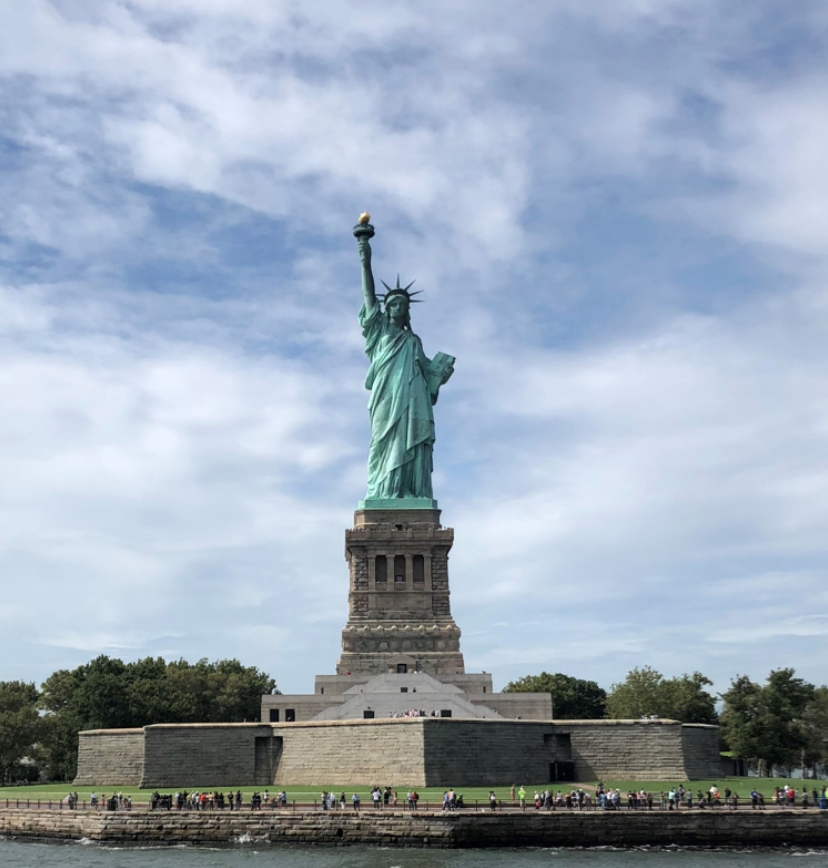Not like the brazen giant of Greek fame,
With conquering limbs astride from land to land;
Here at our sea-washed, sunset gates shall stand
A mighty woman with a torch, whose flame
Is the imprisoned lightning, and her name
Mother of Exiles. From her beacon-hand
Glows world-wide welcome; her mild eyes command
The air-bridged harbor that twin cities frame.
“Keep ancient lands, your storied pomp!” cries she
With silent lips. “Give me your tired, your poor,
Your huddled masses yearning to breathe free,
The wretched refuse of your teeming shore.
Send these, the homeless, tempest-tost to me,
I lift my lamp beside the golden door!”
With these words, Emma Lazarus’ 1883 poem “The New Colossus” paints Lady Liberty as a symbol of hope for people from all over the world arriving in America, in pursuit of a better life. Today, the Statue of Liberty is visited by millions each year, all of whom hope to catch a glimpse of this famous monument. This past summer, I visited the statue, and below, you will find a brief history of the Statue of Liberty, fun facts, and my own travel tips and photographs. Enjoy this guide on the Statue of Liberty!
A Brief History
The Statue of Liberty, officially titled Liberty Enlightening the World, was an idea originally proposed by Édouard de Laboulaye to mark the end of the Civil War. He wanted to present the American people with a monument that symbolized freedom and democracy. The building of the statue was led by three main figures: Frédéric-Auguste Bartholdi, Alexandre-Gustave Eiffel (best known for the Eiffel Tower), and Richard Morris Hunt. The Franco-American Union managed the project, and it was decided that the funding for the project would be divided between both countries. In the end, it was mostly individual donations that funded this colossal endeavor. An iron framework covered in copper, standing approximately 305 feet tall over the New York Harbor, the Statue of Liberty was declared a National Monument in 1924.

Fun Facts
- Engraved on the tablet held by Lady Liberty are the words “July 4, 1776”, the day America declared its independence from Britain with the signing of the Declaration of Independence.
- The broken chains under the Statue of Liberty’s foot symbolize the abolition of slavery.
- If the Statue of Liberty is made of copper, then why is it green? The chemical process of oxidation protects the copper.
- The torch, which is covered in 24 karat gold, can sway up to six inches!

Insider Tips
- The only way to gain access to the Statue of Liberty is by taking a Statue Cruise. It is advised to make reservations in advance. The cruises depart throughout the day both from New York City’s Battery Park and from New Jersey’s Liberty State Park. These cruises provide splendid photo-taking opportunities of the statue, Ellis Island, and the magnificent New York skyline.
- During our trip, my family and I made the 142-step journey up a narrow staircase into the crown of the Statue of Liberty. While this was a unique experience, I found that the view was not as great as the view from the pedestal. One important note is that the only way to ensure access to the crown is to book tickets online months in advance. We booked tickets in April for an August trip.
- Earlier this year, the new Statue of Liberty Museum opened on Liberty Island. The museum boasts a theater, galleries, and a roof deck. Visitors can learn more about the statue’s history, get an up-close look at the original torch, and add themselves to the digital museum archive of visitors.
As a proud American citizen and the daughter of Eastern European immigrants, I was humbled by my visit to the Statue of Liberty. I believe that the statue represents more than American ideals; it represents the constant strive towards liberty for everyone.
What does liberty mean to you?
Planning a trip to the Statue of Liberty? Visit the National Park Service’s website here.
Source Cited
Statue of Liberty National Monument (U.S. National Park Service). 4 Nov. 2019, www.nps.gov/stli/index.htm.



